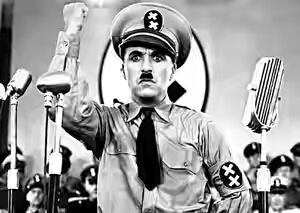April 16 is the 127th birth anniversary of Charlie Chaplin. A quick look at a rare genius entertainer who made the world laugh…
Imagine a man walking down the street in an oversized, baggy suit, tipping his bowler hat to people walking by and occasionally tapping his cane on the pavement. What is distinct about him is that he waddles like a penguin and has a funny looking moustache (known as a toothbrush-style moustache). Now, place him in a clichéd comical situation, for example, the classic slipping-on-the-banana-peel gag. While in most scenarios, this joke would have garnered a few laughs from the audience, we talk about someone who could take this simple joke and run with it for about 10 minutes and have you rolling on the floor laughing. In an era when the world grappled with the struggles of war, economic downturn and depression in general, one man made a difference through his art. Who is he? Charlie Chaplin, the comedic genius.
Rags to riches
Charlie Chaplin was born Charles Spencer Chaplin on April 16, 1889 in London, England. From a young age, Charlie exhibited a great zeal for stage performances and showmanship. He spent a considerable amount of time with dance troupes, but wanted to foray into acting, especially comedy acts. His mother Hannah, who was also a stage performer, encouraged both Charlie and his elder brother Sydney to hone their skills in the performance arts. However, his childhood was fraught with misfortune. His father left them when Charlie was quite young, and his mother fell sick often and was eventually admitted to a mental asylum. Both children were sent to workhouses (this is a public institution in England where poor people who cannot fend for themselves, can get board and lodging, for which they pay through work) and even lived on the streets for a while. Charlie did odd jobs but nurtured his dream of becoming an actor.
By 1908, Charlie, with the help of his brother Sydney, joined a comedy company and became quite popular with the audience with his unique brand of comedy and pantomime, a kind of comedy act using only facial expressions and body movement. Charlie’s novel ideas coupled with slapstick comedy was a laugh riot with the people who flocked to see his shows. His successful stint in the company gave Charlie the chance to tour the U.S., exhibit his act around the country and get more exposure in show business.
But it wasn’t until 1914 that Charlie got the biggest break of his career. After he came to the U.S., Charlie signed on with Keystone Pictures to work on his acting and learn filmmaking. And in those days, films were made without audio. They were known as Silent Movies. It was in the movie “Mabel’s Strange Predicament” that the “Tramp” character was first established. He acknowledged that at the time of dressing up for the character — the trademark baggy suit, big shoes and the ever familiar toothbrush moustache — he had no idea about the character he was about to create. But when he put on the clothes and make up, and walked on stage, his persona was complete and the Tramp was born. And the rest, as they say, is history!
Peak of success
Charlie Chaplin went on to make more short films and feature-length movies based on the Tramp. Some of the Tramp movies with its over-the-top and unexpected humour combined with poignant storylines proved to be the factors that cemented his status among the audience. It is a character that immortalised Charlie Chaplin.
The success he enjoyed, however, had its shortcomings. Chaplin’s personal life often clashed with his professional one and resulted in three unsuccessful marriages. Later, he was targeted by the U.S. government for his political ideologies and the way it reflected in his films. He could no longer stay in the U.S. after his permit was revoked. Charlie spent the rest of his life in Switzerland where he was happy and warmly welcomed.
In 1972, Charlie came back to the U.S., after 20 years, to receive the Honorary Award for his contribution to world cinema. On Christmas Day in 1977, he died in his sleep leaving a deep void no one could fill. On Chaplin’s death, René Clair, French filmmaker, aptly said, “He was a monument of the cinema, of all countries and all times.”
Catch these movies
The Kid (1921): The Tramp takes in an abandoned child and they make an unlikely team. They look out for each other and become inseparable.
The Gold Rush (1925): The Tramp comes to the mines of Klondike to try his luck at striking gold. However, things are not easy when another prospector makes it difficult for the Tramp to go about his business.
The Circus (1928): The clowns and other acts of the circus are nothing compared to the antics of the Tramp who inadvertently joins the circus and has the audience in splits.
City Lights (1931): The Tramp falls in love with a visually challenged flower girl who mistakes him for a rich man. At the same time, he saves the life of a billionaire, who was intoxicated at the time and can’t remember the Tramp after sobering up.
The Great Dictator (1940): A barber comes home years after he left to fight in the Great War, but as the country’s ruler is adamant on persecuting the people of his community, things don’t look too good.



Leave a reply